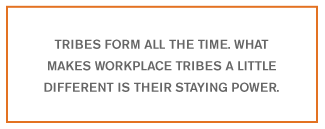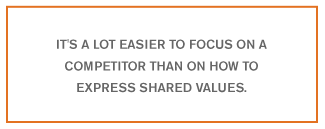The next time you're around a group of coworkers, listen closely to the language they use. If you hear things like "This sucks," or "I think you have leadership potential," or "This will change the world" over and over, you'll have a pretty good idea of the state of that tribe.
So say Dave Logan, Ph.D.; John King; and Halee Fischer-Wright, M.D. in their new book, Tribal Leadership: Leveraging Natural Groups to Build a Thriving Organization. After a 10-year study involving more than 24,000 people in two dozen companies, Logan, King, and Fischer-Wright argue that workgroups are more tribal than departmental, that tribes are ultimately more powerful than companies or executives, and that there are five stages of tribal development.
 |
Why should executives care about tribes? Because Logan, King, and Fischer-Wright have found extraordinary jumps in productivity and profitability as tribes progress. They have also discovered new ways to understand and influence team behavior.
In this interview, Drs. Logan and Fischer-Wright contend that companies can shuffle the boxes on the org chart all they want, but the tribe has the final say. They also reveal why companies should -- and how they can -- leverage tribes stage by stage and why they believe the fifth stage is the future of business.
GMJ: What do you mean by "tribe"?
Dr. Logan: A tribe is usually composed of 20 to 150 people, but what marks it is that it forms naturally.
Dr. Fischer-Wright: From the ice age on, forming a tribe was a way to improve our odds for survival. As we've gotten more sophisticated, it's become a way to increase our odds of success. Tribes can help us marry better, do better in our job, be healthier -- a lot of positive outcomes are associated with tribes.
GMJ: Are workplace tribes different from other kinds of tribes?
Logan: Tribes form all the time. What makes workplace tribes a little different is their staying power. Even if you leave a company, you'll probably keep in touch with some of the people you worked with.
One of the typical reasons that organizational restructuring doesn't work is that companies can mess with the org chart, but that may not have any impact on the informal network of the tribe. The tribe determines whether changes will work, whether people buy in, whether they like the new direction. Business schools don't talk about those naturally occurring groups, yet most leaders are affected by them.
Fischer-Wright: Designating someone as the leader or head of an organization doesn't mean that he or she is the tribal leader. Most of the time, tribal leaders are the silent face behind the leadership. A company can change leadership, but if the new leader isn't the tribal leader, the changes won't have an impact on the tribe.
GMJ: How can you identify the tribal leader?
Fischer-Wright: It's usually obvious who is not the leader, but it's often harder to figure out who is the leader.
Logan: It's harder at the earlier stages because there may not be a tribal leader; sometimes, there are just a lot of subversive elements at work. At stage two, where people tend to gripe a lot, the tribal leader is sometimes the person who puts out the message that "We don't work hard, and we take long breaks, and we don't come up with new ideas." Actually, that person isn't really a leader; he or she is just the most negatively influential person. At stages four and five, the leader is the person who brings the tribe together and gives it a sense of its own identity. The tribe recognizes that person as the leader.
GMJ: What should you do if you're appointed to be a leader? For instance, you're not the tribal leader, but you're asked to lead the tribe?
Logan: The first thing that [appointed] leaders should do is identify these naturally forming groups. That's easy; you just walk around and see who talks to whom. Next, listen to how that group tends to talk. Once you know the lingo, it's not hard to identify the group's developmental stage.
GMJ: Language was important to your research. Why does language at work matter so much?
Fischer-Wright: In my work, I've asked doctors to participate and lead teams, and some of those groups never got any traction. One of the things that I noticed was a commonality of language that distinguished the groups that were successful from the ones that weren't. I could intuitively pick the groups that would be successful from the ones that would never get out of committee.
When I realized that there was a way to quantify what that culture was and how to identify the language of the tribe, I realized this was pure gold. You could identify what group you were in and the likelihood that it would work or not; you could also take steps to make groups successful despite their tribal stage.
GMJ: What do people in different stages say? What's a common language trait of stage-two groups versus stages three or four or five?
Logan: At stage two, group members say things like "My life sucks. They don't listen to us; they don't take our suggestions seriously; nothing will ever change; management's a bunch of idiots; this idea too shall pass; here we go -- here's another dumb idea." [See graphic "Employee Tribes: Five Stages."] Teachers' unions, for example, tend to run in stage two. And in fairness, so do a lot of boards, especially those in death spirals.
At stage three, it's all about me. The most common word you heard is "I," followed by "me" and "my." These group members say things like "I have an idea. I have a plan to turn this group around, and I hope you'll join me in leading this turnaround." Basically, the message is that "I'm great, and you're not." Stage-three group members are personally competitive.
To move to stage four, a tribe needs a sense of shared values. This is when strengths can become really powerful. When individual tribe members embrace their strengths, then they're able to develop plans and strategies that are impossible [to attain] without leveraging a shared sense of vision and values and strengths.
Employee Tribes: Five Stages
|
GMJ: How do you move a tribe from stage to stage?
Logan: There are different leverage points for each stage. If a group has a rigid, bureaucratic culture, and you come in and preach collective values and say, "Anything is possible, and we're going to change the world," folks will just roll their eyes and look at their watches. You have to talk a language they can understand -- at most, one stage above where the group is.
 |
GMJ: Give me an example.
Logan: Say you're working with a group at stage two. First, find the people who want things to be different -- the ones who are tired of the griping. Then talk stage-three language to them individually. Say things like, "I think you have real potential to lead. I think that you could go a long way toward improving things here." If you've chosen the right person, then eventually she'll look at her colleagues and say, "You're right -- I'm great, and this situation sucks." You've moved that person to stage three. Then the jujitsu move is that person does the same thing for someone else.
GMJ: How about the higher levels? How do you bump a tribe from stage three to stage four, or from four to five?
Logan: To move from stage three to stage four, first figure out what people value individually by asking them a series of open-ended questions, then start constructing multiperson initiatives. Make it impossible for people to succeed without partnering with someone else. One of the characteristics of stage three is two-person relationships. A person at stage three wants to control other people, but he doesn't want those people comparing notes. So he tries to keep them apart.
To move a group to stage four, you have to flip that on its ear. A stage-four leader tries to bring people together at work to form three-person relationships. If you anchor those relationships on values, you can create a culture of people embracing shared values. Success is no longer about "me," it's now about "us." Now it becomes "We're great."
GMJ: Are there differences in productivity from stage to stage?
Fischer-Wright: Big ones. Stage five outperforms four, which outperforms three, etc. We often find groups at stage four reporting a three thousand percent increase in profitability [over groups at stage three].
GMJ: Why is it so hard to sustain stage five?
Logan: It's a lot easier to focus on a competitor than on how to express shared values. Stage five requires transitioning from a focus on competition to a shared sense of what everybody's searching for. It only happens about two percent of the time, and it's unstable. We've seen it at Genentech, at parts of IBM, and at parts of General Electric. We've also seen it at Pixar and Apple. But it's rare for a company to sustain it.
But here's what's interesting about stage five: Companies produce things that shake their industry. Stage-five tribes change the world. And it can be hard to measure their impact in profitability. For example, how do you measure the impact of the graphic-user interface? It's probably a two-trillion-dollar idea if you aggregate its impact.
Groups at stage five can achieve things that are inconceivable for groups simply aiming to outperform the competition. They can move into a realm of pure creativity, pure leadership, pure innovation. They say, "Let's do it because it's possible and we think it will change the world." The profitability, the build-out that comes from stage five often continues for decades. At first I was skeptical that stage-five tribes even existed because they were so rare. Now I'm convinced they are the future of business.
-- Interviewed by Jennifer Robison